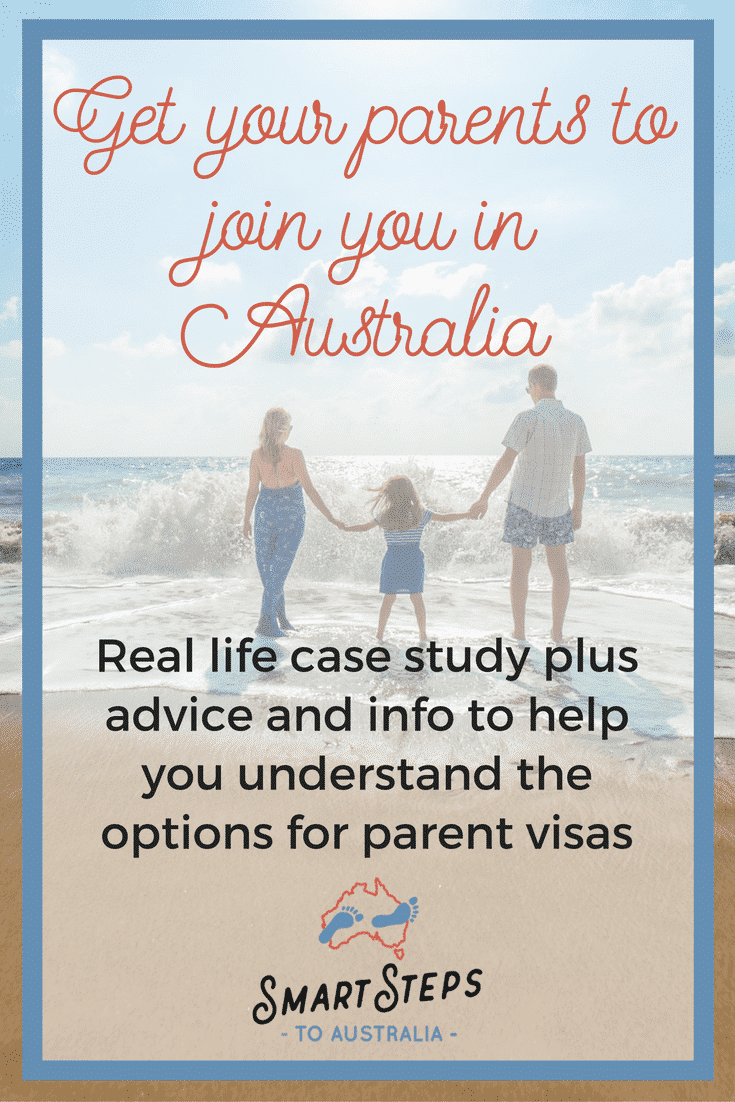I was in a migration Facebook group recently and I saw lots of people talking about parent visas. I know that some families move out here in the hope they’ll one day be able to move their parents over to Australia too, so I thought I’d write a post about how to bring parents to Australia.
As it’s not something I’ve done myself, I’ve enlisted the help of my friends who brought their parents over to Sydney to tell their story, and also Veronika from Sort Out My Visa who is the migration agent we used to move to Australia. Veronika outlines the facts and the practicalities involved in moving your parents to Australia in the second half of the post.
Please note: This post was accurate when it was originally published in December 2016. The rules and regulations change frequently, so please contact Veronika Hurbis for the most up-to-date information about parent visas Australia, contributory parent visa waiting time, temporary parent visa options etc.
Real life story: How I brought my parents to Australia
I asked my friend Simon to tell me a bit about his experience of his parents moving out to join him in Sydney. (That’s Simon’s family in the cover photo which was taken as his parents arrived in Australia.)
“My parents visited us in 2004 during the first year we came to Sydney. They fell in love with the place straight away and from that moment onwards I think it was always in the back of their minds to make a permanent move over.
“Over the next four years, they visited us four or five more times and each time the urge to stay grew. Two other factors sealed the deal. My sister and niece visited in 2010 and they also couldn’t believe the standard of living in Oz. As my sister worked in child care, getting her permanent visa was a breeze as it was at the upper end of the list of workers Australia needed at the time. Once my sister was over, which also tied in nicely with my parents’ retirement age, they got in touch with a migration agent and got the ball rolling.
“They started selling off their belongings back in the UK, and timed the sale of their house to when the visa would be granted. A risky gamble in some ways, but knowing both their kids were waiting in sunny Sydney made it all worth it.
“My parents came over on a Contributory Parent Visa (Subclass 143). This allowed them to migrate to Australia permanently. It opens the door for them to get full citizenship when they have the four years. The time it takes to get this is short. I think my parents took about 18 months from start to finish. Then they were done and had permanent residency. No worries about their visas changing or running out etc. The costs, however, are high. They are basically paying for a full access visa into the country.
“My parents used a migration firm to help. They took care of all the paperwork, knew exactly what forms needed to go where, etc. It was quite full-on in terms of the paperwork and I think my parents would have struggled to get through it all on their own. Plus having someone at the end of an email or phone call gave them peace of mind.
“They’ve been over here now for over two years. Two more and they’ll go for their citizenship, there’s no stopping them now and they love the Australian way of life.”

How to get a parent visa in Australia
If you’re wondering ‘how can I bring my parents to Australia?’, or you’re a parent with kids who have settled in Australia and you’re looking at your options, migration agent, Veronika Hurbis from Sort Out My Visa, has the answers below.
Veronika explains*:
If you have a child who has moved to Australia on a permanent basis and you want to move to Australia or visit Australia for longer periods of time, here are your options:
TOURIST VISAS
If you are not quite sure if you want to move over to join your children on a permanent basis, you may want to consider an extended Tourist Visa (subclass 600) instead. This visa allows parents to have regular extended visits with their family in Australia without needing to apply for a new visa on each visit and also recognise the length of the Parent visa queue.
Multiple entry visas with a maximum stay of 12 months will be considered on a case-by-case basis with maximum validity periods of up to:
- five years for parents outside Australia and in the Parent visa (subclass103) queue;
- three years for parents outside Australia who have:
- had a previous Australian visa and complied with the conditions; and
- have not applied for a Parent visa; or
- have applied for a parent visa but are not yet in the Parent visa (subclass103) queue; and
- 18 month for parents who have:
- not previously travelled to Australia; and
- have not applied for a Parent visa; or
- have applied for a Parent visa but are not yet in the Parent visa (subclass103) queue.
You have to remember that if you’ve recently stayed in Australia for an extended period (12 months) you won’t be considered for a longer Tourist visa until you have spent a minimum of 6 months outside Australia in the last 18 months at the time you apply for a new Visitor visa.
Parent visa checklist
If you are sure that you want to move to Australia to be with your children permanently then the best visa to apply for is a Parent Visa. There are a few different Parent Visa options. For all of them you have to make sure that:
1) At least half of your children (including step children) are based in Australia as permanent, settled residents. For example, if you and your partner have two children in total, and one of those children is an Australian Permanent Visa holder and is living in Australia, then you will be fine. If you have three children but two are living outside of Australia, then you cannot apply for a parent visa.
2) One of your Australian resident children has to sponsor your visa application. That child must have lived in Australia for at least two years. (If your Australian child is married to an Australian citizen this rule is more flexible.)
3) You and your partner must be of good health and you must not have a serious record of convictions.
For example, if you are on regular medication for a medical condition, that should be fine. But if you have recently had cancer it is possible that you will not pass the health test. Another example is if you have had a string of driving convictions. If these spread out over a lifetime of driving, then that should be fine. But if your driving convictions have led as far as you having to spend time in jail, you may not pass the character test.
If you are confident that you are able to meet the above criteria, then you may be eligible for one of the available Parent Visas. And these fall into these categories:
Contributory Parent Visa Australia – the fast but expensive option
The Contributory Parent Visa is the fastest way to permanent residency as a parent of an Australian-based child.
This parent visa involves making a non-refundable deposit to the Australian government. This amount is about AUD$43,600 per migrating parent. In addition, you will also have to pay bond monies of up to AUD$14,000. This bond will be refunded after 10 years.
The Contributory Parent Visa waiting time is relatively short. This visa is processed in approximately 24 months. The contributory amounts are requested once the parents have passed health and police checks. The parents become permanent resident when the visa is granted.
If one of the parent applicants is aged 65 years or over you may be able to apply for this visa while you are in Australia and you will be able to stay in Australia while the visa is being processed.
Aged Parent Visa Australia – the slow but inexpensive option
This non-contributory aged parent visa is much cheaper (the costs run into a few thousand rather than tens of thousands) but this visa has an extremely long processing time (over 25 years). If one of the parent applicants is aged 65 years or over you may be able to apply for this visa while you are in Australia and you will be able to stay in Australia while the visa is being processed. But you will not be able to work or receive any social security payments and you will have to apply for a special Bridging Visa if you want to travel out of Australia during the processing time.
This visa is only suitable for parents who are happy to wait for their visas to be processed in Australia even if this means that they will be waiting decades, that they will not be able to work, they will not receive social security help while they are in Australia, they may have to obtain Health Insurance and they will not generally be able to travel out and return to Australia on a regular basis.
WARNING
Generally parent visa fees increase, in line with inflation, in January and July each year. However, the Department is considering introducing significant changes to the current Parent Visas in 2017. In particular, the Department may introduce a new, more expensive temporary longer term parent visa next year. If this happens the Department may get rid of the above visas, so permanent parent visas may no longer be an option, or they may become even more expensive.
So if you do think that you meet the Parent Visa requirements and you do think that you may want to move to Australia to join your children on a permanent basis, do it now: as long as you get an application in before any changes to the current visa system, you will be fine.
For more information about Parent Visas visit the Department’s website.
Are your parents considering moving to Australia?
Thanks so much for Veronika for taking the time to explain the visa options for moving your parents to Australia. I know how complicated visas are, so it’s great to see the list of options clearly laid out. It’s also really handy to have the heads up about the changes that may be coming. As with all visas, if your parents are thinking about moving to Australia and they’re eligible now, the best time to get on with the application is RIGHT NOW!
*All information provided in by Veronika was correct as of 8th December 2016 and is given in good faith. It is advisable to seek professional advice to ensure you receive the most up-to-date information about visas because things change and advice gets out of date fast.
















